CBSE 12th Board Exams Begin in 7 Days: Check CBSE 12th Physics Chapter 7 Important Questions
Students can refer to the CBSE 12th Physics Chapter 7 Important Questions and solutions here to prepare for their upcoming CBSE Board Exam 2023.
CBSE 12th Physics Chapter 7 Important Questions: The Central Board of Secondary Education (CBSE), India, will conduct the class 12 Board exams between Feb 15 to Apr 5, 2023.
The Physics exam is scheduled for Mar 6. Students completing their CBSE 12th Physics revision must thoroughly study the seventh chapter, i.e., CBSE 12th Physics Alternating Current.
Continue reading further to check the CBSE 12th Physics Chapter 7 Important Questions and their solutions.
Also Read: Check CBSE 12th Physics Chapter 5 Important Questions
CBSE 12th Physics Chapter 7 Important Questions & Solutions
Find the CBSE 12th Physics Chapter 7 Important Questions and solutions for the seventh chapter (Alternating Current) below.
- Question 1: The instantaneous current and voltage of an a.c. circuit are given by i = 10 sin 300 t A and V = 200 sin 300 t V. What is the power dissipation in the circuit?
Answer: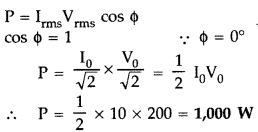
- Question 2: The instantaneous current and voltage of an a.c. circuit are given by i = 10 sin 314 t A and v = 50 sin 314 t V. What is the power dissipation in the circuit?
Answer:
- Question 3: Define the term ‘wattless current’.
Answer: Wattless current is that component of the circuit current due to which the power consumed in the circuit is zero. - Question 4: Mention the two characteristic properties of the material suitable for making the core of a transformer.
Answer: Characteristic properties of material suitable for the core of a transformer :- It should have high permeability
- It should have low hysteresis loss.
- It should have low coercivity/retentivity.
- It should have high resistivity. (Any two)
- Question 5: When an ac source is connected across an ideal inductor, show on a graph the nature of variation of the voltage and the current over one complete cycle.
Answer: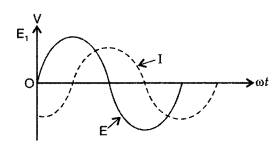
- Question 6: A heating element is marked 210 V, 630 W. What is the value of the current drawn by the element when connected to a 210 V dc source?
Answer:
- Question 7: Why is the core of a transformer laminated?
Answer: The core of a transformer is laminated to minimize eddy currents in the iron core. - Question 8: A heating element is marked 210 V, 630 W. Find the resistance of the element when connected to a 210 V dc source.
Answer:
- Question 9: Why is the use of AC voltage preferred over DC voltage? Give two reasons.
Answer: AC voltage is preferred over DC voltage because of the following reasons :- it can be stepped-up or stepped-down by a transformer.
- carrying losses are much less.
- Question 10: Define capacitor reactance. Write its S.I. units.
Answer: ‘Capacitor reactance’ is defined as the opposition to the flow of current in ac circuits offered by a capacitor.
S.I. Unit: Ohm. - Question 11: A variable frequency AC source is connected to a capacitor. Will the displacement current change if the frequency of the AC source is decreased?
Answer: On decreasing the frequency of the AC source, reactance, xC=1ωC will increase, which will lead to a decrease in conduction current. In this case ID = IC Hence, displacement current will decrease. - Question 12: Plot a graph showing the variation of capacitive reactance with the change in the frequency of the AC source.
Answer: Graph showing a variation of xc capacitive reactance with the change in frequency of AC source.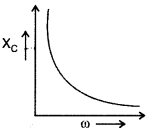
- Question 13: For an ideal inductor, connected across a sinusoidal ac voltage source, state which one of the following quantity is zero :
(i) Instantaneous power
(ii) Average power over a full cycle of the AC voltage source
Answer: Average power over a full cycle of the ac voltage source is zero when connected with an ideal inductor. - Question 14: The circuit arrangement as shown in the diagram shows that when an a.c. passes through coil A, the current starts flowing in coil B.
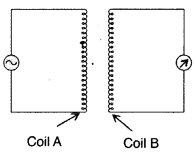
(i) State the underlying principle involved.
(ii) Mention two factors on which the current produced in coil B depends.
Answer: (i) It is based on the principle of “mutual induction”.
(ii) Two factors are:- distance between the coils.
- orientation of the coils.
- Number of turns in the coil, (any two)
- Question 15: The figure given shows an arrangement by which current flows through the bulb (X) connected with coil B, when a.c. is passed through coil A.
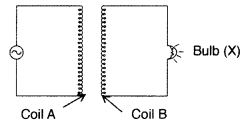
(i) Name the phenomenon involved.
(ii) If a copper sheet is inserted in the gap between the coils, explain, how the brightness of the bulb would change.
Answer:
(i) The phenomenon involved is mutual induction.
(ii) When the copper sheet is inserted, eddy currents are set up in it which opposes the passage of magnetic flux. The induced emf in coil B decreases. This decreases the brightness of the bulb. - Question 16: A 15.0 µF capacitor is connected to 220 V, 50 Hz source. Find the capacitive reactance and the RMS current.
Answer: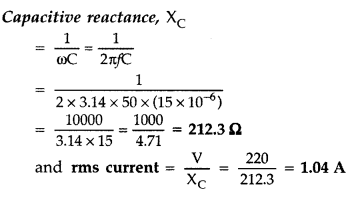
- Question 17: An electric lamp having a coil of a negligible inductance connected in series with a capacitor and an AC the source is glowing with a certain brightness. How does the brightness of the lamp change on reducing the
(i) capacitance, and
(ii) the frequency? Justify your Answer. (Delhi 2009)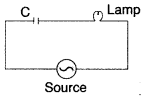
Answer: Brightness of lamp ∝ I0, Assuming zero resistance and zero inductance of lamp
On reducing C or v; It would decrease ∴ Brightness of the lamp will decrease. - Question 18: State the principle of working of a transformer. Can a transformer be used to step up or step down a DC voltage? Justify your Answer.
Answer: The transformer works on the principle of mutual induction, i.e., when a changing current is passed through one of the two inductively coupled coils, an induced emf is set up in the other coil.
No, the transformer cannot be used to step up or step down a DC voltage because d.c. voltage cannot produce a change in magnetic flux. - Question 19: A light bulb is rated 100 W for a 220 V ac supply of 50 Hz. Calculate
(i) the resistance of the bulb;
(ii) the RMS current through the bulb.
Answer:

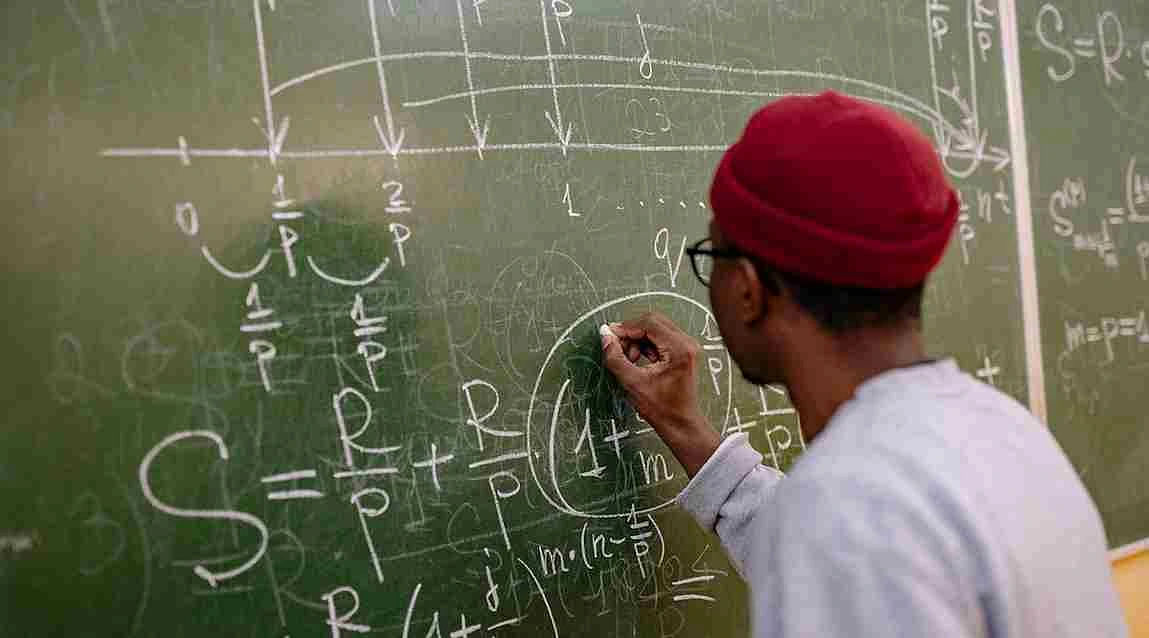


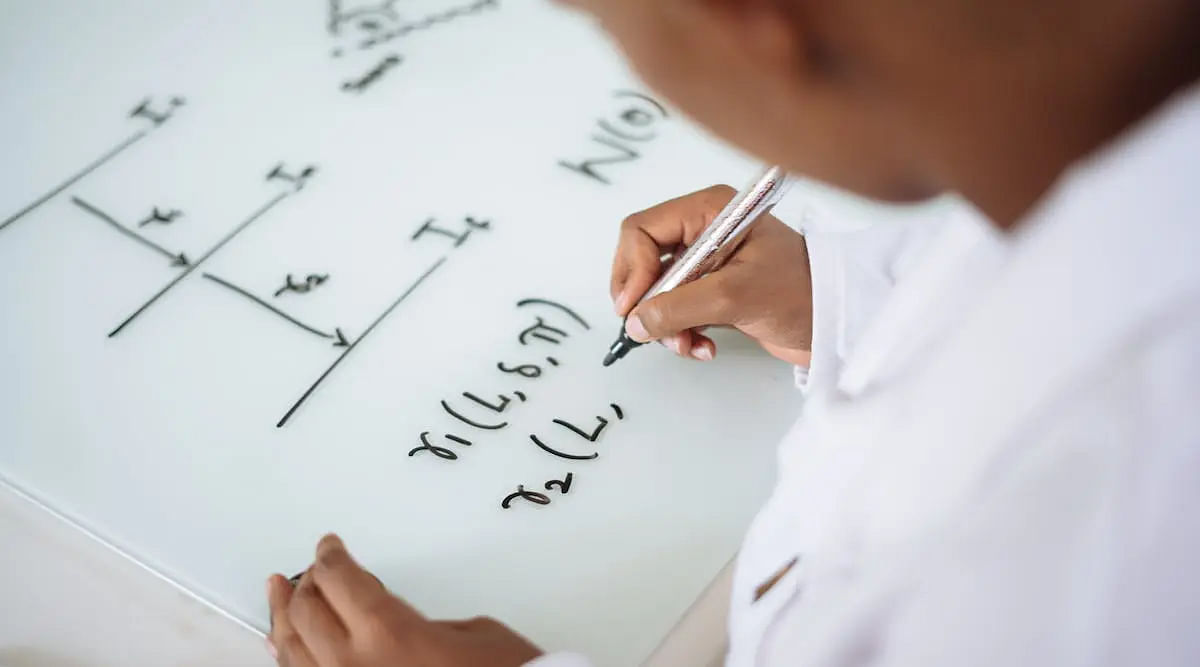




POST YOUR COMMENT